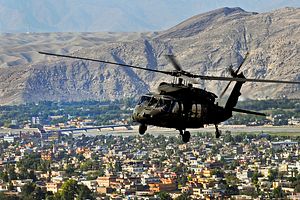The latest supplementary budget request, intended to fund U.S. wars in Iraq, Syria, and Afghanistan, as well as counter-Islamic State (ISIS) efforts, includes $264 million for American-made Black Hawk helicopters. The Black Hawks will replace Russian-made Mi-17s used by Afghan security forces. The White House sent the supplementary budget request to Congress last week. According to Pentagon officials they have already notified and briefed Congress regarding the helicopters. The intention is to end reliance on Russian made Mi-17 helicopters in support of the Afghan National Defense and Security Forces (ANDSF).
“When the Pentagon buys helicopters, they should be made in America,” U.S. Senator Chris Murphy said in an interview.
The decision was made following long run efforts by Murphy, U.S. Senator Richard Blumenthal, and U.S. Representative Rosa DeLauro. They have been at the forefront of the effort urging the Pentagon to end its reliance on Russian helicopters and to field an American alternative to the Mi-17s in Afghanistan. This decision takes place at an important time, as the transition from the Obama administration to the Donald Trump administration is already underway. Trump has vowed that he will give priority to American manufacturers first and keep jobs inside the United States.
According to the plan, the 53 currently available Black Hawks will be refurbished and modified in accordance to the environment of Afghanistan. Eventually the number will reach 159. Out of the 159 helicopters, 58 will be modified with fixed forward-firing armaments to add aerial firing capability.
U.S. officials say these helicopters will cost less and will prove more effective compared to Russian Mi-17s.
Initially Mi-17 helicopters were contracted in Afghanistan because the aircraft were easier to fly compared to more advanced U.S.-made helicopters and were well-suited to the environment and high elevations of Afghanistan. Moreover, Afghan pilots were more familiar with Mi-17s. Russia has delivered 63 Mi-17 helicopters to Afghanistan since 2001, when a contract was signed between its state arms exporter Rosoboronexport and the U.S. Department of Defense.
One of the major objections over the Mi-17 contract is that U.S. taxpayer money is going to Russia through this contract. “Millions of American dollars should never have gone to Russia for Mi-17 helicopters instead of Sikorsky Black Hawks — a travesty that will now be stopped,” Blumenthal said in an interview. After the Crimea crisis in 2014, Washington imposed sanctions on Russia; however the helicopters contract remained intact.
The modification and refurbishing of Black Hawks will take at least two years. It is expected that the first batch of Black Hawks will reach Afghanistan before the summer of 2019. Meanwhile the already contracted Mi-17 sustainment package will continue as the transition to the new helicopters takes place. This will address the Afghan security forces’ requirements to some extent. Developing the Afghan Air Force’s capability was ignored for a long time. However, with recent U.S. emphasis on strengthening Afghanistan’s aerial capabilities, major developments have been made. Under this initiative A-29, C-208, C-130, PC-12, and MD-530 aircraft have been provided to Afghanistan. These aircraft have given significant leverage to the Afghan security forces in the war against insurgents. Particularly in the eastern Nangarhar province, during the fight against ISIS, these were the aircraft that gave Afghan security forces major leverage, according to Afghan security officials.
Afghan security forces are fighting on 15 to 20 fronts each day with an elusive enemy. Taliban militants, along with different non-state actors like al-Qaeda and ISIS, are all in fight against Afghan security forces and U.S. troops in the country. The emergence of new non-state actors like ISIS has further raised concerns that the conflict could extend to Central Asian countries. This year, Afghan security forces are believed to have suffered their worst losses since 2001, with the military estimating 2016 fatalities at more than 5,000 so far.
Air power is essential to any military engagement in a counterinsurgency campaign. Air power provides a counterweight to the advantages the insurgents may have on the ground. This is particularly important for Afghanistan where the relatively newly trained Afghan security forces are involved in fight against a brutal enemy on various fronts. Replacing Mi-17s with Black Hawks will not only help in the fight against insurgents, it will keep the U.S. taxpayer money in the U.S. contractors’ hand and is a good example of the U.S. long-term commitment to Afghanistan.
Before becoming Defense Liaison at the Embassy of Afghanistan in Washington D.C. Ahmad Shah Katawazai worked with the Ministry of Foreign Affairs of Afghanistan. Katawazai has a Master’s degree in international relations and a second Master in Global Security Studies from the Johns Hopkins University. Katawazai is a freelance writer. You can follow him on Twitter at @askatawazai.
































